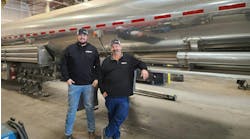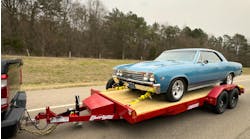It was a diverse gathering of people who share an interest in trailer underride accidents: trailer manufacturers, people who have been impacted by collisions with trailers, people who buy trailers, highway safety advocates, and government officials who regulate trailers. They all gathered together at the Insurance Institute for Highway Safety May 5 to explore ways to make trucks and trailers safer.
The roundtable was sponsored by IIHS, the Truck Safety Coalition, and AnnaLeah and Mary for Truck Safety. The goal was to examine the scope of the problem and explore ways to reduce the risks through voluntary action and regulation. Better underride guard designs, guards for the rear and sides of single-unit trucks, increased conspicuity, stronger enforcement of existing laws, and adoption of crash avoidance systems were among the countermeasures explored.
The event centered around a successful crash test of a newly designed Stoughton underride guard (see May TBB, Page 17). Prior to the crash test, representatives from the National Highway Traffic Safety Administration and the National Transportation Safety Board presented statistics on traffic accidents involving trucks and trailers. A panel discussion followed the test, focusing on potential next steps.
A few weeks earlier, J B Hunt announced it was buying 4,000 Wabash trailers equipped with a new underride guard. Like the Stoughton design, the new Wabash guard proved itself in a similar crash test.
“We had no idea if there would be a safety marketplace for large trucks when we began our crash tests,” Matthew Brumbelow, an IIHS senior research engineer, said. “We at the Institute have been really encouraged by the response from trailer manufacturers.”
Mark Roush, vice president of engineering with Vanguard, participated in the afternoon panel discussion. Vanguard is one of the trailer manufacturers that voluntarily improved their underride guards.
“As far as we knew we were producing trailers to what we thought was the highest regulatory standard, and then the IIHS test came in and made us aware of what was happening,” Roush said. “Three of our largest customers forwarded letters from you [Karth] asking us to do more.”
Among the recommendations for doing more: side underride guards for trucks (see previous story) and reducing the number of trailers exempt from underride guard regulations.
David Zuby, IIHS executive vice president and chief research officer, wrapped up the day with a call for continued cooperation and research.
“The one thing I hope everyone takes away from this is that there has been a lot of progress in recent years on underride crashes, and there will be more ahead. We are optimistic that we can solve this problem working together.” ♦











